The GIGABYTE Z170X-UD5 TH Motherboard Review: An Entry to Thunderbolt 3
by Ian Cutress on February 19, 2016 9:00 AM EST- Posted in
- Motherboards
- Gigabyte
- Thunderbolt
- Skylake
- Z170
- Thunderbolt 3
System Performance
Not all motherboards are created equal. On the face of it, they should all perform the same and differ only in the functionality they provide - however this is not the case. The obvious pointers are power consumption, but also the ability for the manufacturer to optimize USB speed, audio quality (based on audio codec), POST time and latency. This can come down to manufacturing process and prowess, so these are tested.
Power Consumption
Power consumption was tested on the system while in a single MSI GTX 770 Lightning GPU configuration with a wall meter connected to the OCZ 1250W power supply. This power supply is Gold rated, and as I am in the UK on a 230-240 V supply, leads to ~75% efficiency > 50W, and 90%+ efficiency at 250W, suitable for both idle and multi-GPU loading. This method of power reading allows us to compare the power management of the UEFI and the board to supply components with power under load, and includes typical PSU losses due to efficiency. These are the real world values that consumers may expect from a typical system (minus the monitor) using this motherboard.
While this method for power measurement may not be ideal, and you feel these numbers are not representative due to the high wattage power supply being used (we use the same PSU to remain consistent over a series of reviews, and the fact that some boards on our test bed get tested with three or four high powered GPUs), the important point to take away is the relationship between the numbers. These boards are all under the same conditions, and thus the differences between them should be easy to spot.

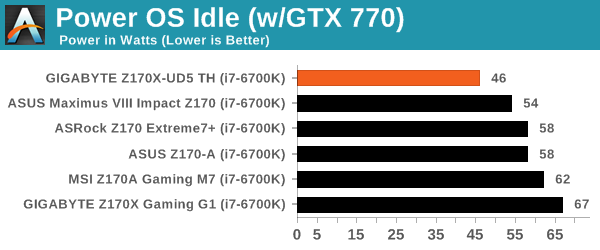
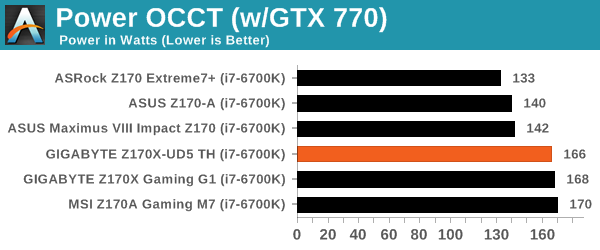
The GIGABYTE board is surprising low for idle loading, beating out the mini-ITX ROG model, but the load-to-idle delta of 122W is the highest we’ve seen from any Z170 motherboard so far.
Non UEFI POST Time
Different motherboards have different POST sequences before an operating system is initialized. A lot of this is dependent on the board itself, and POST boot time is determined by the controllers on board (and the sequence of how those extras are organized). As part of our testing, we look at the POST Boot Time using a stopwatch. This is the time from pressing the ON button on the computer to when Windows 7 starts loading. (We discount Windows loading as it is highly variable given Windows specific features.)
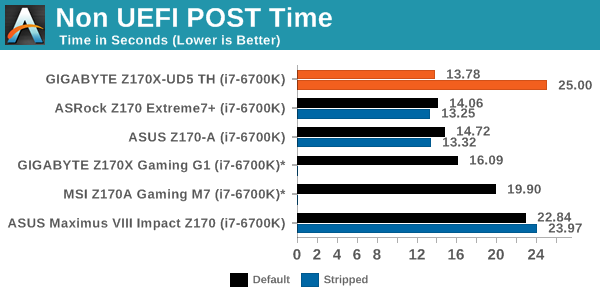
The GIGABYTE Z170X-UD5 TH also does really well in our POST time analysis, making the default POST time the fastest we’ve seen. Attempting to do a ‘stripped’ POST time through disabling controllers caused the system to take longer however.
Rightmark Audio Analyzer 6.2.5
Rightmark:AA indicates how well the sound system is built and isolated from electrical interference (either internally or externally). For this test we connect the Line Out to the Line In using a short six inch 3.5mm to 3.5mm high-quality jack, turn the OS speaker volume to 100%, and run the Rightmark default test suite at 192 kHz, 24-bit. The OS is tuned to 192 kHz/24-bit input and output, and the Line-In volume is adjusted until we have the best RMAA value in the mini-pretest. We look specifically at the Dynamic Range of the audio codec used on board, as well as the Total Harmonic Distortion + Noise.

THD + N for Z170X-UD5 TH at 50% volume
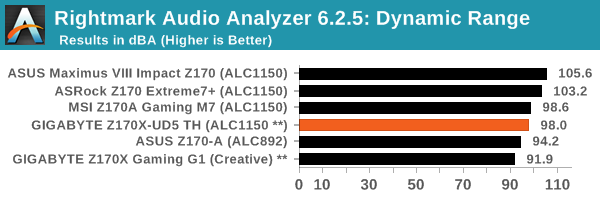
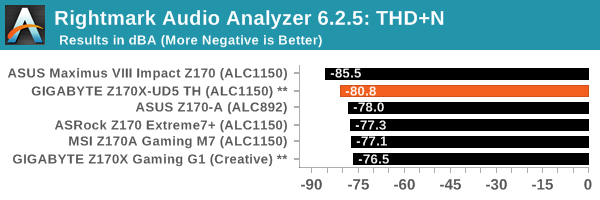
We’ve had issues with GIGABYTE’s premium audio interface and our testing in the past; either due to driver settings or the additional software, running the speaker volume at 100% causes a large amount of distortion in our signal resulting in very poor results. In fact, any volume over 67% caused this issue. We reduced the volume to 50% to take some measurements, with all the audio software tools uninstalled as much as possible, and we had some reasonable performance out of it in the end. Ultimately GIGABYTE has told us in the past that 100% volume in most circumstances is probably not a realistic interpretation of user experience, but I’m still not keen on the large amount of software interference and the user should be able to use the codec bare if wanted.
USB Backup
For this benchmark, we transfer a set size of files from the SSD to the USB drive using DiskBench, which monitors the time taken to transfer. The files transferred are a 1.52 GB set of 2867 files across 320 folders – 95% of these files are small typical website files, and the rest (90% of the size) are small 30 second HD videos. In an update to pre-Z87 testing, we also run MaxCPU to load up one of the threads during the test which improves general performance up to 15% by causing all the internal pathways to run at full speed.
Due to the introduction of USB 3.1, as of June 2015 we are adjusting our test to use a dual mSATA USB 3.1 Type-C device which should be capable of saturating both USB 3.0 and USB 3.1 connections. We still use the same data set as before, but now use the new device. Results are shown as seconds taken to complete the data transfer.
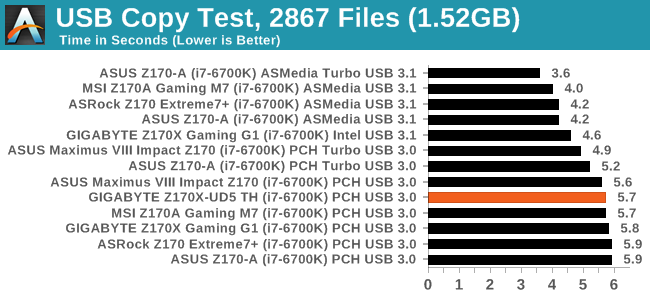
In USB 3.0 performance, the Z170X-UD5 TH runs a similar line to the other Z170 motherboards tested. Also like other Alpine Ridge motherboards, it breaks our test for USB 3.1 and we were unable to get a result. Our software indicates the copy being finished before it actually has finished (essentially reporting when the ‘send’ signal completes rather than the ‘received and correct’ signal comes back), reporting speeds in excess of USB 3.1 is capable of. This seems to be due to Alpine Ridge rather than anything else.
DPC Latency
Deferred Procedure Call latency is a way in which Windows handles interrupt servicing. In order to wait for a processor to acknowledge the request, the system will queue all interrupt requests by priority. Critical interrupts will be handled as soon as possible, whereas lesser priority requests such as audio will be further down the line. If the audio device requires data, it will have to wait until the request is processed before the buffer is filled.
If the device drivers of higher priority components in a system are poorly implemented, this can cause delays in request scheduling and process time. This can lead to an empty audio buffer and characteristic audible pauses, pops and clicks. The DPC latency checker measures how much time is taken processing DPCs from driver invocation. The lower the value will result in better audio transfer at smaller buffer sizes. Results are measured in microseconds.

It would seem that some manufacturers are still feeling out DPC Latency on the platform, with ASUS going below 100 and almost everyone else hitting over 200. I expect this should get better over the life cycle of the platform.










29 Comments
View All Comments
GoMoeJoe - Friday, February 19, 2016 - link
Any Z170 based mobo *that still uses a shared M.2 is unacceptable.Especially the way these clowns did it on this product ...
nehway0912 - Saturday, February 20, 2016 - link
There is a fw update for alpine ridge today. Can you retest the usb 3.1 performance with the lastest fw?jabber - Saturday, February 20, 2016 - link
Wake me up when I can buy a TB3 card for £10 and a TB3 caddy for around the same. No rush.garfieldalvin - Monday, February 22, 2016 - link
Any test perform on the TB3 port for read write data rate, displayport daisy chain with multi monitors?Zak - Friday, February 26, 2016 - link
Thunderbolt will never take off among consumers and enthusiasts due to cost and poor implementation in peripherals that make their price less attractive than USB. I have a TB2 dock and TB2 drive enclosure. USB3 in the dock maxes out at 350MB/s. SSDs mounted in the enclosure max out at 390/360MB/s R/W. All docks and all enclosures have this speed cutoff. And they're very expensive for what you get.olePigeon - Tuesday, April 12, 2016 - link
I don't think you quite understand what Thunderbolt is. Thunderbolt is essentially an external connector to your PCIe BUS. You don't compare it to USB. Sometimes it is USB because that's what you run on it. The advantage to Thunderbolt is that it is whatever you want it to be, including USB.Thunderbolt 3 currently combines either the USB 3 type C connector or DisplayPort 1.2 with PCIe in a single serial signal. This allows you to connect anything you would normally put into your PCIe slot. Many items can be found in the form of an adapter, such as ethernet, USB, SATA, etc.; others can be connected via an external PCIe slot such as video cards, audio cards, and more.
Thunderbolt doesn't compare to USB, it coexists.
WarlordBB - Monday, March 21, 2016 - link
With TB3 coming to several of Gigabytes Gaming boards, is this board worth it when the G1 is about the same price? Granted you get 2 TB3 instead of 1, but still:http://www.gigabyte.com/mb/thunderbolt3/overview
WarlordBB - Monday, March 21, 2016 - link
I meant the G7coldlogic - Tuesday, May 3, 2016 - link
Can anyone point me in the right direction to understand how TB3 passes video through from the GPU?